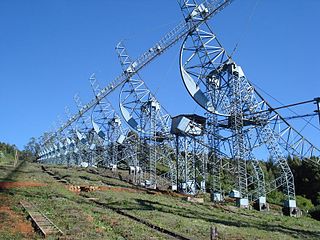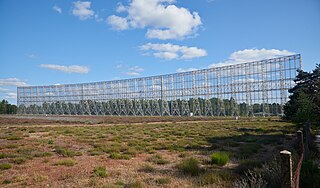
A radio telescope is a specialized antenna and radio receiver used to detect radio waves from astronomical radio sources in the sky. Radio telescopes are the main observing instrument used in radio astronomy, which studies the radio frequency portion of the electromagnetic spectrum emitted by astronomical objects, just as optical telescopes are the main observing instrument used in traditional optical astronomy which studies the light wave portion of the spectrum coming from astronomical objects. Unlike optical telescopes, radio telescopes can be used in the daytime as well as at night.

The Square Kilometre Array (SKA) is an intergovernmental international radio telescope project being built in Australia (low-frequency) and South Africa (mid-frequency). The combining infrastructure, the Square Kilometre Array Observatory (SKAO), and headquarters, are located at the Jodrell Bank Observatory in the United Kingdom. The SKA cores are being built in the southern hemisphere, where the view of the Milky Way galaxy is the best and radio interference at its least.

The Molonglo Observatory Synthesis Telescope (MOST) is a radio telescope operating at 843 MHz. It is operated by the School of Physics of the University of Sydney. The telescope is located in Hoskinstown, near the Molonglo River and Canberra, and was constructed by modification of the east–west arm of the former Molonglo Cross Telescope, a larger version of the Mills Cross Telescope.
The Mills Cross Telescope was a two-dimensional radio telescope built by Bernard Mills in 1954 at the Fleurs field station of the Australian Commonwealth Scientific and Industrial Research Organisation in the area known now as Badgerys Creek, about 40 km west of Sydney, New South Wales, Australia.

The Low-Frequency Array, or LOFAR, is a large radio telescope, with an antenna network located mainly in the Netherlands, and spreading across 7 other European countries as of 2019. Originally designed and built by ASTRON, the Netherlands Institute for Radio Astronomy, it was first opened by queen Beatrix of The Netherlands in 2010, and has since been operated on behalf of the International LOFAR Telescope (ILT) partnership by ASTRON.
The Mauritius Radio Telescope (MRT) is a synthesis radio telescope in Mauritius that is used to make images of the sky at a frequency of 151.5 MHz. The MRT was primarily designed to make a survey with a point source sensitivity of 150 mJy. Its resolution is about 4 arc min.

The Interplanetary Scintillation Array is a radio telescope that was built in 1967 at the Mullard Radio Astronomy Observatory, in Cambridge, United Kingdom, and was operated by the Cavendish Astrophysics Group. The instrument originally covered 4 acres. It was enlarged to 9 acres in 1978, and was refurbished in 1989.

The National Centre for Radio Astrophysics is a research institution in India in the field of radio astronomy is located in the Pune University Campus, is part of the Tata Institute of Fundamental Research, Mumbai, India. NCRA has an active research program in many areas of Astronomy and Astrophysics, which includes studies of the Sun, Interplanetary scintillations, pulsars, the Interstellar medium, Active galaxies and cosmology and particularly in the specialized field of Radio Astronomy and Radio instrumentation. NCRA also provides exciting opportunities and challenges in engineering fields such as analog and digital electronics, signal Processing, antenna design, telecommunication and software development. NCRA has set up the Giant Metrewave Radio Telescope (GMRT), the world's largest telescope operating at meter wavelengths located at Khodad, 80 km from Pune. NCRA also operates the Ooty Radio Telescope (ORT), which is a large Cylindrical Telescope located near Udhagamandalam, India.

The Indian Institute of Astrophysics (IIA), with its headquarters in Bengaluru, is an autonomous research institute wholly financed by the Department of Science and Technology, Government of India. IIA conducts research primarily in the areas of astronomy, astrophysics and related fields.

The Institute of Astronomy of Nicolaus Copernicus University in Toruń, known prior to 1 October 2019 in scientific publications as the Toruń Centre for Astronomy, is an optical and radio observatory located at in Piwnice, about 15 km north of Toruń, Poland. It houses two single-dish antenna telescopes, 32 metres and 15 metres in diameter, as well as the largest Polish optical telescope – 90 cm Schmidt-Cassegrain camera. The facility is operated by the Nicolaus Copernicus University. Also, photometry using 60 cm Cassegrain telescope is made and radio measurements of the Sun at 127 MHz frequency have been recorded on a daily basis since 1958 using a 23 m interferometer.

The Medicina Radio Observatory is an astronomical observatory located 30 km from Bologna, Italy. It is operated by the Institute for Radio Astronomy of the National Institute for Astrophysics (INAF) of the government of Italy.

The Murchison Widefield Array (MWA) is a joint project between an international consortium of organisations to construct and operate a low-frequency radio array. 'Widefield' refers to its very large field of view. Operating in the frequency range 70–300 MHz, the main scientific goals of the MWA are to detect neutral atomic Hydrogen emission from the cosmological Epoch of Reionization (EoR), to study the sun, the heliosphere, the Earth's ionosphere, and radio transient phenomena, as well as map the extragalactic radio sky. It is located at the Murchison Radio-astronomy Observatory (MRO).

Astrosat is India's first dedicated multi-wavelength space telescope. It was launched on a PSLV-XL on 28 September 2015. With the success of this satellite, ISRO has proposed launching AstroSat-2 as a successor for Astrosat.

Leibniz Institute for Astrophysics Potsdam (AIP) is a German research institute. It is the successor of the Berlin Observatory founded in 1700 and of the Astrophysical Observatory Potsdam (AOP) founded in 1874. The latter was the world's first observatory to emphasize explicitly the research area of astrophysics. The AIP was founded in 1992, in a re-structuring following the German reunification.

The Ooty Radio Telescope (ORT) is located in Muthorai near Ooty, in southern India. It is part of the National Centre for Radio Astrophysics (NCRA) of the Tata Institute of Fundamental Research (TIFR), which is funded by the Government of India through the Department of Atomic Energy. The radio telescope is a 530-metre (1,740 ft) long and 30-metre (98 ft) tall cylindrical parabolic antenna. It operates at a frequency of 326.5 MHz with a maximum bandwidth of 15 MHz at the front end.
Govind Swarup was a pioneer in radio astronomy. In addition to research contributions in multiple areas of astronomy and astrophysics, he was a driving force behind the building of "ingenious, innovative and powerful observational facilities for front-line research in radio astronomy".

Pushchino Radio Astronomy Observatory is a Russian radio astronomy observatory. It was developed by Lebedev Physical Institute (LPI), Russian Academy of Sciences within a span of twenty years. It was founded on April 11, 1956, and currently occupies 70 000 square meters.

The Argentine Institute of Radio Astronomy (IAR) was created in 1962 through an agreement between the scientific agencies CONICET and CIC, and the universities of La Plata and Buenos Aires. Its functions are to promote and coordinate the research and technical development of radio astronomy in Argentina and to collaborate in the teaching and dissemination of astrophysics and related disciplines. The Institute continues its activities in the dependency of the National Council of Scientific and Technical Research (CONICET), the Commission of Scientific Research of the Province of Buenos Aires (CICPBA) and the National University of La Plata (UNLP). Its current director is Dr. Gustavo E. Romero and its deputy director, Dr. Jorge A. Combi.

The Nançay Radio Observatory, opened in 1956, is part of Paris Observatory, and also associated with the University of Orléans. It is located in the department of Cher in the Sologne region of France. The station consists of several instruments. Most iconic of these is the large decimetric radio telescope, which is one of the largest radio telescopes in the world. Long established are also the radio heliograph, a T-shaped array, and the decametric array operating at wavelengths between 3 m and 30 m.

Giant Ukrainian Radio Telescope is a low frequency radio telescope which is being developed, built and operated by Institute of Radio Astronomy of National Academy of Sciences of Ukraine. It is located at S. Y. Braude radio astronomical observatory in Kharkiv oblast of Ukraine. The GURT system is designed to be an extension of Ukrainian T-shaped Radio telescope, second modification (UTR-2) in terms of spatial dimensions and frequency range. The goals of creating this new instrument include enhancement of UTR-2 functional properties and contribution to the progress of low frequency radio astronomy in synergy with other distant instruments.


















